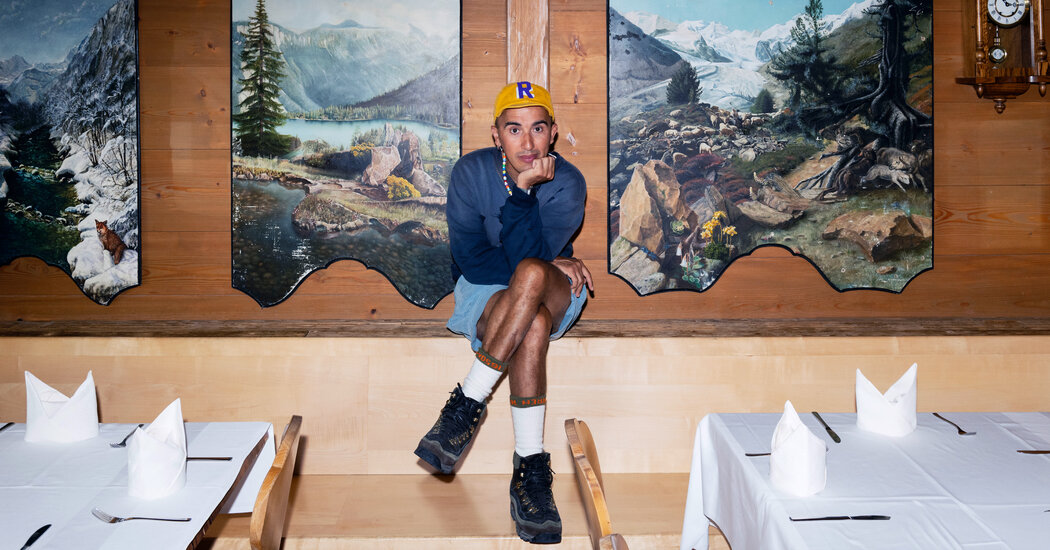Many designers aspire to the polymath label, but no polymath is as hard and ruthless as Ramdane Touhami, whose latest pursuit combines merchandising, marketing and selling his favorite activity: walking.
Mr. Touhami is known for acting impulsively and with intensity. He has lived in New York and Tokyo and owns 51 bicycles, including one of three by French architect-designer Jean Prouvé that are known to still exist.
The 49-year-old French-Moroccan once owned a donkey polo club in Tangier, Morocco; became menswear director at Liberty department store in London; and spent years reshaping the beauty industry, reviving the fortunes of scented candle maker Trudon as creative director and then the historic apothecary brand Buly 1803, which he sold to LVMH in 2021.
Mr Touhami bought, restyled and reopened the Hotel Drei Berge in the Swiss Alps last year, and opened the mountain sports boutique A Young Hiker in Paris in January.
It has been a long climb to the top. At school he launched a successful T-shirt line that corrupted the Timberland logo and made a fortune, but then he was kidnapped and made out of a lot of money. He then became a homeless skateboard obsessive, navigating the streets of Paris with no fixed abode.
But recently, from the headquarters of his agency Art Recherche Industrie, formed from a decadent 19th-century ballroom in the 10th arrondissement, he has masterminded the restyling of silver clothier Christofle and leather goods house Moynat, as well as his own podcasts, publishing projects and household articles.
His explanation for the new activities in Switzerland and at A Young Hiker: “Beauty was my job; mountains are my passion.”
The conversation has been edited and condensed.
Opening a store selling hiking gear between the Parisian flagships of Serge Lutens and Rick Owens is quite a statement. Why there?
I wanted a store with a view of nature and the windows overlook the Jardin du Palais Royal. It’s a spectacular place. You have customers who are more relaxed, with more time on their hands. It’s not a shopping center. Most people who go there just hang out and have ice cream or coffee. They are not random tourists; they are people who know the place. A Young Hiker is a community; many people come just to talk about their gear and where to climb. It reminds me of the skateboard places where I used to hang out all day without buying anything. We also organize weekends in the mountains in Fontainebleau, outside Paris.
Paris is now your base. Was opening A Young Hiker always the first place you thought of?
No no no. The large store in Tokyo will open in September in the Daikanyama district, also a very green district. I only open stores where I like to hang out and go alone, not for economic reasons. It has to suit my mental comfort. Trump got elected the week after we opened a Buly in Bergdorf Goodman in New York, so we closed it and left.
Walking is a fashion moment – Louis Vuitton’s latest campaign shows Roger Federer and Rafael Nadal strolling through Italy’s snow-capped Dolomites, dressed in light knits and T-shirts, and strapped into small Vuitton backpacks filled with climbing ropes. How different is your opinion?
The global story associated with the mountains consists of all Swiss chalets and American outdoor clothing. It’s a pure white world. But there are mountains in Africa and Asia. Nobody knows that you can ski in Congo and that there is a glacier. I have two sides to my brain: I grew up in Europe, but I want to show what’s happening around the world. I only stock mountain brands from Asia.
How did you decide what to sell?
They are all brands that I buy, or from people I know. I have a close relationship with Setsumasa Kobayashi of Mountain Research, whose concept is anarchy in the mountains, and I love that. We’ve talked a lot about 19th century naturalist Henry David Thoreau. There is a very intellectual side to all of this. It’s all about bringing new colors and atmosphere to the mountains, both with people and with design. We are now traveling together with the Rastas of the Jahiking Club in Paris.
There are many conversations in fashion about gender and circularity. Do they play a role in what you do?
We have different sizes in stock, from very small to extra large and there is no gender attached. It’s technical clothing. You don’t make a technical skirt. Being waterproof and weatherproof are the most important things. With my own personal brand going into stores, we’re going to be making things that have absolutely no plastic involved. Next week we will be stocking vintage pieces from the 60’s through the 70’s. We’ve searched the world over the past year and found the best there is: North Face from 50 years ago, pieces no one has seen before. I’m trying to create a new market in luxury for this kind of vintage.
Why does walking have such a colorful aesthetic?
You don’t wear black in the mountains. If something happens to you, you have to be visible. Outdoor brands only started making things in black when they realized people were buying their stuff to wear in cities. I developed the Drei Berge textile collection together with Fischbacher 1819, which we debuted in Milan this year, and the three different fabrics are all woven in bright colors. I recently attended the opening of a hotel in Nice, in the south of France, and it was all beige. The planet has so many colors, why not use them?
Fashion is currently mainly about merchandise, and you elevate it to an art form. A young hiker makes ceramics, umbrellas, bandanas and rock-shaped candles with the typography you developed for Drei Berge. How does the hotel fit into your design practice?
The hotel is a laboratory. That’s all it is. The paneling on the umbrella is a collection of logos and colors associated with different mountains. Fashion is about everything being the same, but this is expressive. When I opened the hotel, I decorated 17 rooms, but left two untouched so that my friends Aaron Aujla and Emily Adams Bode Aujla [designer of the Bode fashion label] could create something. What they did was really surprising, using jockey silk and horse show ribbons. I didn’t want a hotel that was all my own work. It was a fantastic experience; We made sheets together based on American horse blankets, with show names on them. I really like the idea of someone waking up in the sheets we designed, in the room we designed, and then going to the bathroom and brushing their teeth with a brush and toothpaste from us, using soap from us . I want it all, from A to Z. I like the idea of creating a world with my own logic.
You have loved walking for 25 years. What’s the appeal?
It’s therapy for me. Every pore of your body is happy in the mountains, with the clear air and water. If you stay at an altitude above 1,500 meters for at least six months of the year [4,920 feet], you live 10 or 15 years longer than average. I’m one of the biggest nerds when it comes to hiking. I have 22,000 mountaineering magazines that I have collected over the last ten years. I spoke to the CEO of VF Corporation, owner of North Face, five days ago and he didn’t know where his own archives were. I told him they were at Utah State University. I had been there the week before. I know what I’m talking about.
With Buly you looked back at calligraphy, imagery and interiors from the 19th century. What was the main historical inspiration for A Young Hiker?
One of my biggest inspirations was the Kibbo Kift walking group of the 1920s, which started as an anti-fascist movement in rural England. It was about getting back to nature. It seems that Nazis are coming again, also in France, and we have to go back to this ideology. They want to destroy everything; we must protect it. Maybe nature is the answer.





